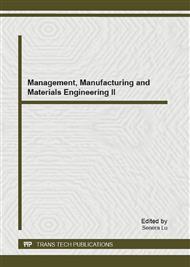[1]
Bollerslev, T. Generalized Autoregressive Conditional Heteroscedasticity[J]. Journal of Econometrics, 1986, 31: 307-327.
DOI: 10.1016/0304-4076(86)90063-1
Google Scholar
[2]
C. Brooks, A.D. Clare, J.W. Dalle Molle, G. Persand. A comparison of extreme value theiry approaches for determining value at risk [J]. Journal of empirical finance, 2005, 12: 339-352.
DOI: 10.1016/j.jempfin.2004.01.004
Google Scholar
[3]
Christoffersen,P. Evaluation interval forecasts[J]. International Economic Review, 1998, 39: 841-862.
Google Scholar
[4]
Engle, R. Autoregressive Conditional Heteroscedasticity with Estimates of the Variance of United Kingdom Inflation[J]. Econometrica. 1982, 50: 987-1007.
DOI: 10.2307/1912773
Google Scholar
[5]
Huisman, R., K. G. Koedjk, and R. A. J. Pownall. VaR-X: Fat Tail in Financial Risk Management[J]. Journal of Risk. 1998, 1(1): 47-61.
Google Scholar
[6]
Kupiec,P. Techniques for verifying the accuracy of Risk measurement models [J]. Journal of Derivatives, 1995, 3: 73-84.
Google Scholar
[7]
McNeil and Frey, Estimation of tail-related risk measures for heteroscedastic financial time series: an extreme value approach [J]. Journal of empirical finance, 2000, 7: 271-300.
DOI: 10.1016/s0927-5398(00)00012-8
Google Scholar
[8]
Mike K.P. So, Philip L. H. Yu. Empiricial analysis of GARCH models in value at risk estimation [J]. Int. Fin. Markets, Inst. and Money, 2006, 16: 180-197.
DOI: 10.1016/j.intfin.2005.02.001
Google Scholar
[9]
Neftci, S.N. Value at Risk calculations, extreme events, and tail estimation [J]. Journal of Derivatives, 2000: 23-37.
DOI: 10.3905/jod.2000.319126
Google Scholar
[10]
Cont, R. Empirical properties of asset returns: stylized facts and statistical issues[J]. Quanitative Finance, 2001, volume 1: 223-236.
DOI: 10.1080/713665670
Google Scholar
[11]
Tse. The conditional heteroscedasticity of the Yen–Dollar exchange rate[J]. Journal of Applied Econometrics. 1998. 13: 49-55.
DOI: 10.1002/(sici)1099-1255(199801/02)13:1<49::aid-jae459>3.0.co;2-o
Google Scholar
[12]
Viviana Fernandez, Risk management under extreme events[J]. International Review of Financial Analysis, 2005, 14: 113-148.
DOI: 10.1016/j.irfa.2004.06.012
Google Scholar
[13]
Wagner and Marsh, Measuring tail thickness under GARCH and an application to extreme exchange rate changes[J]. Journal of empirical finance, 2005, 12: 165-185.
DOI: 10.1016/j.jempfin.2003.11.002
Google Scholar
[14]
Yong Bao, Tae-Hwy Lee and Burak Saltoglu, Evaluating Predictive Performance of Value-at-Risk Models in Emerging Markets: A Reality Check[J]. Journal of forecasting, 2006, 25: 101-128.
DOI: 10.1002/for.977
Google Scholar


